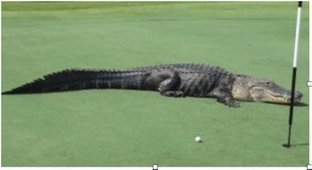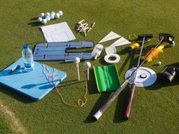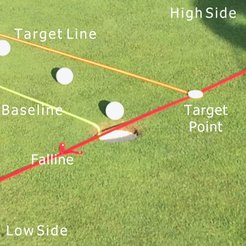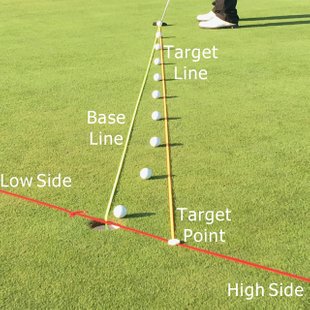"You don’t necessarily have to be a good golfer to be a good Putter, but to be a good golfer you need to be a good Putter." - Author Unknown
Throughout the years, many books, films etc. have been made on the subject of putting. Some of these ideas are pure nonsense, while others have some good lining and truth in them.
Pelz, Chuck Hogan, Aimpoint, Vector putting are good examples of good learning. The most complete is by far PuttingZone as it integrates all the necessarily skills. Personally I am grateful for everything I learnt from Geoff Mangum.
It can be a jungle of information but after a few weeks of practise and understanding you can be able to start to ”coach” yourself at the golfcourse, even in competitions.
Putting is very individual and some things must be personalised. The basics are always there and that is the base to learn, improve and be good in Putting. Here you can learn to cut strokes and be a part of ”Positive Putting”.
Improve Yourself
The game on the green plays a big part, around 50% of golf is on the greens.
Some of us may never be able to hit the ball as accurately , powerful or
consistently as a scratch player, but with constructive work, we can realistically hope to putt like one. If you are struggling to break 90,
about a third of thedifference between you and the players who shoot
even par are those six puts per round they make and you don't.

Some putts are "Harder" than others

"The Toolbox"
Learning & Trainingaids
According to the statistics, if your handicap is 36, the
average is41 putts, for a 9 handicapper its 32 putts. For a scratch player it is 29 putts per round so of course you need modern fundamentals and understanding "how and why", followed by some practice before you can expect to become a good putter.
There are some Basic Fundamentals in Putting and I will use the PZ vocabulariesas they are correct and distinct. Feedback and self-confidence comes by itself.
Putting is a big part of golf and is a “game within the game”.
Here we have to develope basic fundamentals, find the touch and tempo to deliver the ball as we want and work on the FOUR SKILLS.
Fundamentally, the FOUR BASIC SKILLS every golfer needs
to master for putting are:

All Top-ranked Players Controls the Distance
- READING THE GREEN ….. determine an effective target to aim at, serving both line and distance.
- AIMING THE PUTTER-FACE AND BODY………aim the putter-face and the setup straight at the target
-ROLLING THE BALL (STROKE) ……….. putt the ball straight away from the putter face on the same line as it aims at address
- CONTROLLING DISTANCE…..roll the ball with good touch so it always arrives with the same terminal (arrival) speed at the hole, regardless of the length of the putt.
Of these skills for outstanding putting — reading, aiming, stroking, and controlling distance (touch),
the distance control is by far the most important, since touch is the basis for reading and stroking. Without good rhythm (touch), the golfer never reaches his or her potential on the green. A good putter normaly have a natural slow controlled tempo.
Below you can compare your putting with the real good ones - they have nothing that you don't have!
HOLED PUTTS – Putting Statistics PGA Tour & Analyze
From 1 m | From apx 2m | From apx 3m | From apx 6m | From apx 10m | |
Best Player | 100% | 82% | 66% | 12% | 1,62% |
20th Player | 99,8% | 69% | 50% | 9,3% | 1,02% |
100rd Playe | 99,4% | 69% | 40% | 7% | 0,52% |
Summary
From 1 meter all players perform well but from 2 meters one clearly sees that there starts to be a difference in the success percentages.
3m is like a magic borderline. The best player has 66% of holed
putts and the 20th only make 50%.
At competitions, most Golf Federations recommend that the
hole/flag-position shall be placed on a flat area approximately
2 meters around the hole. Most of the time it is also pretty flat up to 3m.
If you would be able to hole 75% of your putts from 3 m, it will change your scoring massively.
Above 3 meter the "percentage" drops a lot. The Top 50 players in the world

Tamber on Tour
The best 10 players are also in top from 6m are at the moment best from apx 6m with 12% holed putts. From 10m the best putters in the world get less than 2 balls out of 100.
The "Empirical" Conclusion:
To become Worldclass
For me it is obvious: – Read the greens correctly & Control distances to avoid disasters – Make most putts inside 3 meters!
The Big Picture
You must be able to see “The Big Picture” ……. what putting (and short game) have to do with scoring…….. In putting we learn the skills from the ground and up. Look at the PDF file about "The Big Picture".
You have three shots that determine what sort of demands you face for putting:
- the first putt after hitting the green in regulation
- the first putt after chipping on for a par save after missing the green in regulation
- the putt remaining after a lag putt or a chip-on for par save…..

US PGA Champion-
Shaun Michel
POSITIVE Putting Reminders
When you start to master the first 3 of the 4 necessary skills for Putting you can move on to practise and find the Target-point and learn to read the greens. Here are some reminders for you.
Find Slope in %.
The slope up to 1 - 3 meters around the hole is the most important. Normally the greens are fairly flat and not tilted more than 3% in this area.
When you find the lowest side of the hole you go 1m ”down” on the Fall-line.
If ”LEVEL-difference” is 1cm the slope is 1%, if difference is 2cm the slope is 2%, 3cm gives 3% and so on. It is easier to see from 2m so you go 2m down ”the Falline and the difference is 2cm, the slope is then 1%, 4cm is 2% and so on. You must work, learn and determine the slopes.
How fast is the Green?
Stimp-meter and Coreputt.
The use of the Stimp-meter is world standard in measuring how quick the greens are.
The ”Stimp” number of 10 means the ball rolls 10 feet on a flat surface. In general one
can say that in average the Stimp-number of 10 is a ”normal quick summer green”.
Further down you find Quick References in Stimp and Break Factors.
Core Putt
When you get used to your CORE-PUTT and its relation to the Stimp-speed your
understanding of the BREAK-FACTOR will increase and putting gets much easier and fun.
The Core-putt shall be Your Personal Stimp-meter, your brain will after some practice
automatically learn the greens speeds.

The intended Falline goes via the Holes highest and Lowest point. If you "roll" a ball on that line it will travel straight. The Falline is also called the 0-Break Line.
SHORT EXPLANATION OF THE CORE-PUTT
The Core Putt is to calibrate your ”relationship with the greens” speed that particular day. Your Coreputt is done with your own tempo, normal, relaxed ”pendulum gravity” putt. Normally the length of the pendulum (putt) starts lite outside the right shoe and Finnish outside the left one, same size
on both sides of the centre.
The Coreputt has always the same size and tempo. It is your personal stimpmeter.
Your brain notifies the ”actual speed” of the greens that day and coordinate your distance control automatically.

- The Base Line is always the straight line to the centre of the hole.
- The Target-Line is always aiming straight to the TARGET-POINT.
- The ball always starts its "travel "on the Target Line until Slope and Gravity affects it.
Read the Greens.
When you start to master the Set up, Aim and (roll) ”Putt” the Ball straight where the
putter face aims and you start to control distances, (to have a good touch). It is now the
time the brain starts to learn and understand the relationship between Slope and
Correct Aim.
Slowly you see all this working together and you will start to learn to read the greens.
All skills must be included to learn and get experience in green reading.
Get involved. It is fun and most awarding.
If you continuously put the ball in wrong directions, with wrong speed your brain get lost and confused,
nothing will be learned. To get feed back and get experience you need to use the ”4 skills”.
Stimp Speed and Your Target Point
Take:
Distance in meters x Slope % x Break-Factor (for the Greenspeed) This gives a target point on the upside off the Falline.
Example: You are 5m from the hole and the slope is 3%. The green condition is a normal quick summer green (Stimp 10) so in this case you use Break-Factor 4.
Formula:
5m x 3% = 15 and then 15 x Break-Factor 4 = 60cm
Your target or aim point is now 60cm from the centre of the hole on the upside on the Falline.
On a flat surface with 3% tilt 5m around the hole you use and aim to the same TARGET-POINT and
the "energy" you need in your putt is to that TARGET-POINT on a FLAT HORISONTAL GREEN. This means if it is an uphill put the target-point will be further away from the the ball, if the putt is downhill the point will be closer. Note again: Energy needed as on a flat horizontal green.
QUICK REFERENCES
BREAK-FACTORS TO USE
STIMP-VALUE | BREAK-FACTOR | STATUS GREEN |
2 | BF 2 | Slow Wintergreen |
8 | BF 3 | |
10 | BF 4 | Normal Summer Green |
12 | BF5 | Fast Summer Green |
14 | BF 6 | "AUGUSTA NATIONAL" |
You only need to know Factor 3,4 and 5 to start.
When you get used to your ”CORE-PUTT” your break-factor and understanding will come by itself.
The Core-putt will develop and be Your Personal Stimp-meter Your brain will after some practice automatically take care of this.
Question:
You are 3m from the hole. Slope is 2%, It is a fast summer green with a Stimp of 12. How many cm shall you place the TARGET-POINT on the high side of the Falline? (Use the Break-Factor for Stimp 12).
Copyright © Tamber Golf 2024